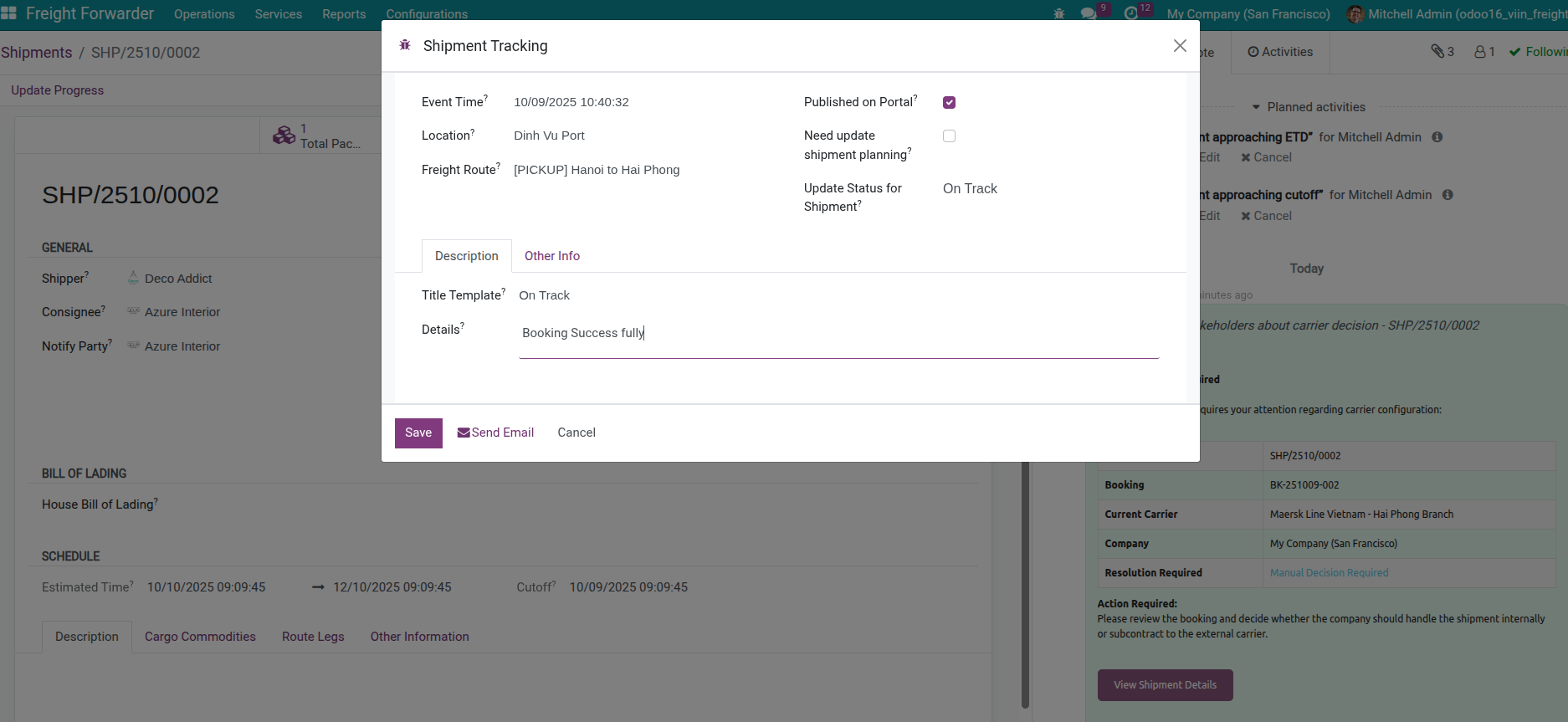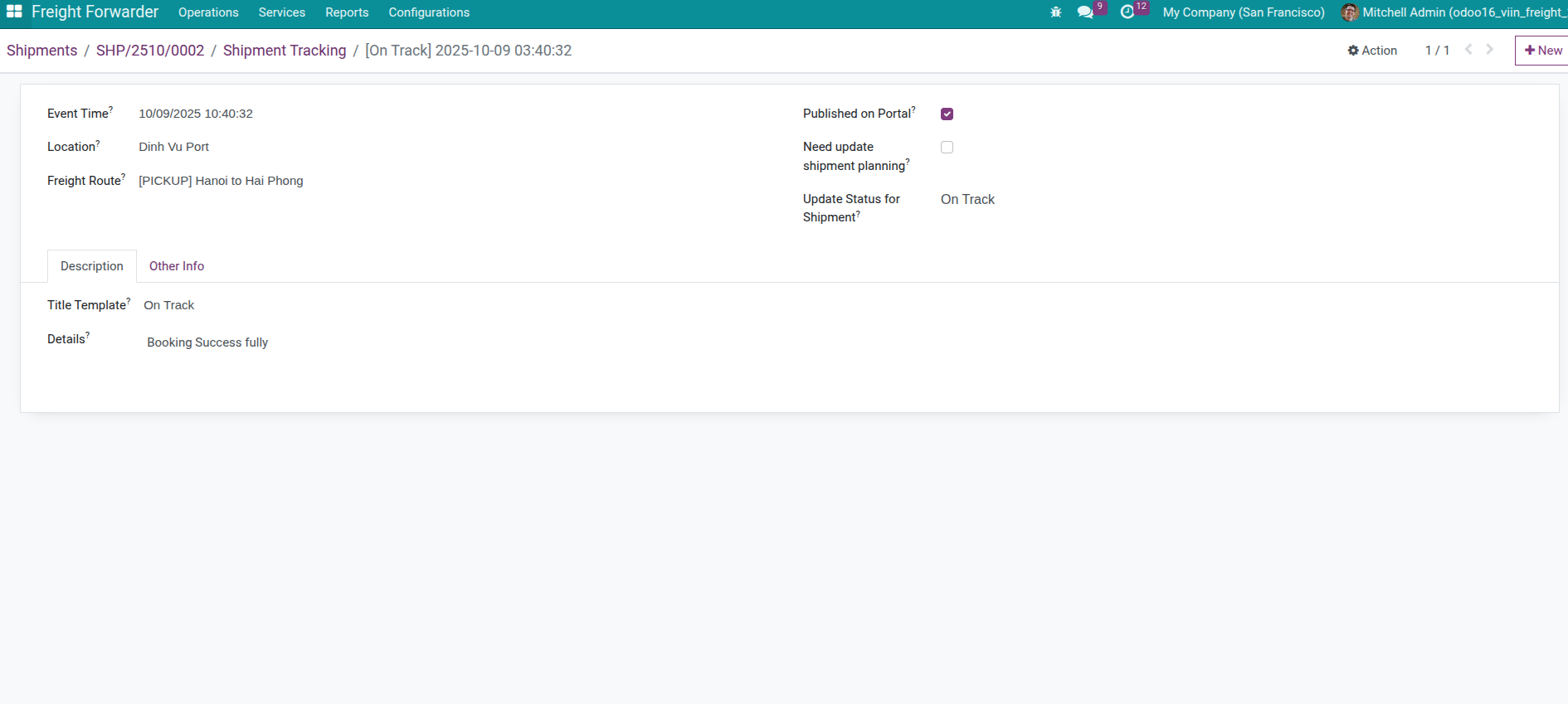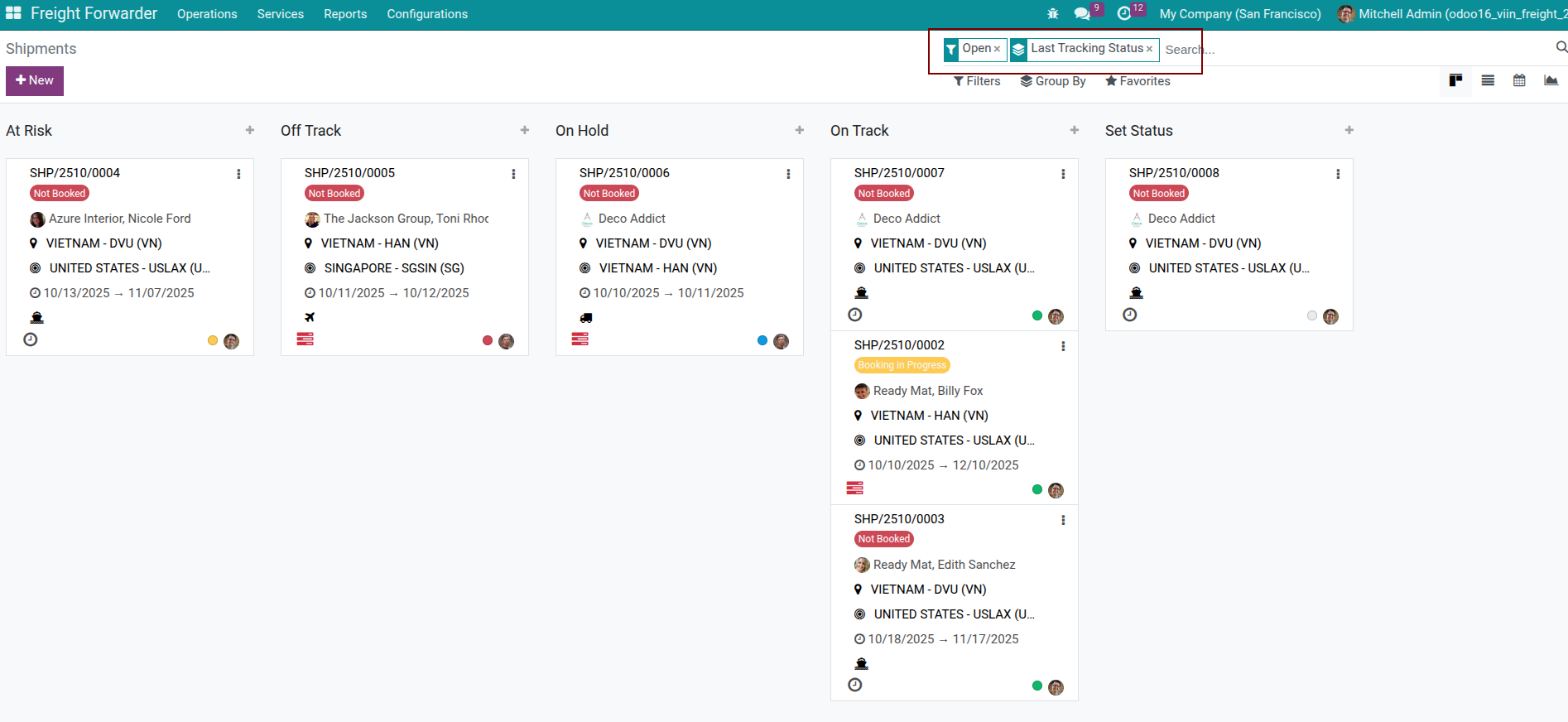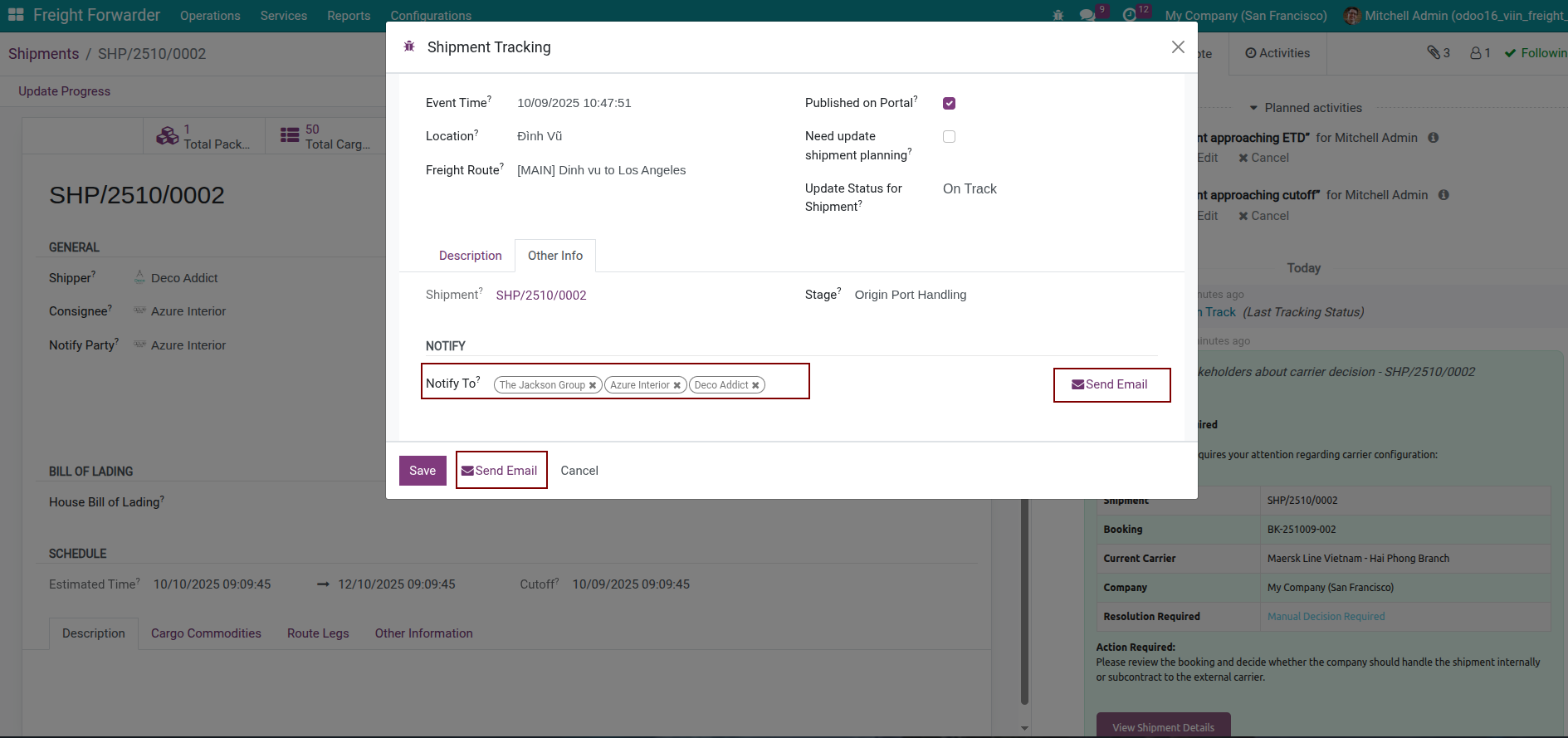Update Shipment Progress¶
Requirements
This guide requires the following applications:
Updating shipment progress regularly keeps customers informed and gives internal teams early warning if a shipment slips from the plan.
Basic Concepts¶
Before starting, you need to understand three important concepts:
Shipment Stage¶
Stage is major steps in the transport journey. Each shipment will go through stages in order:
Planning: Newly created shipment, arranging route, carrier, schedule.
Customs Clearance: Export customs clearance procedures, preparing documents for cargo to exit.
Origin Port Handling: Receive cargo, pack container, transfer to port, load on ship/airplane.
International Transport: Cargo on route by sea/air/land to foreign country.
Destination Port Handling: Unload cargo, import customs clearance procedures, take cargo out of port.
Domestic Delivery: Transport from port to customer warehouse.
Shipment Completed: Delivered cargo, finalize documents and payment.
Note
Not every shipment goes through all 7 stages. For example, domestic shipments can skip customs clearance and international transport stages. You can configure appropriate stages for each shipment.
Tracking Event¶
Event is specific things that happen in each stage. One stage can have multiple events.
For example, in “International Transport” stage, can have events:
Ship departed from Cat Lai port
Ship stopped at Singapore port for transshipment
Ship arrived at Long Beach port (USA)
Each event needs to record clearly:
Title (select from available template or enter manually)
Time (when it happened)
Location (where)
Details (additional description if needed)
Shipment Status¶
Status indicates whether everything is going smoothly. There are 4 statuses:
On Track: On schedule, everything going as planned, no issues.
At Risk: Warning signs, may be delayed. Example: bad weather, customs requests additional documents.
Off Track: Already delayed compared to expected. Example: ship delayed, customs hold.
On Hold: Must pause waiting to handle issue. Example: missing permits, customer hasn’t paid.
Tip
Distinguish between Stage and Status:
Stage answers the question: “What step is cargo at?”
Status answers the question: “Is the situation okay?”
Example: Shipment is at “International Transport” stage (on sea) but status is “At Risk” (ship delayed 2 days).
Progress Update Workflow¶
Step 1: Access Shipment¶
You can access shipment needing update in two ways:
- From sales order:
Open confirmed sales order
Click Shipment button in top corner
- Directly from menu:
Go to Freight Forwarder > Operations > Shipments
Find and select shipment needing update

Step 2: Open Progress Update Form¶
On shipment form, click Update Progress button in top corner. System will open new form for you to enter event information.

Step 3: Fill in Event Information¶
In progress update form, you need to fill in the following information:

Mandatory information:
Title Template: Select available template or create new.
Example: “Cargo loaded on ship”, “Under customs clearance”, “Successfully delivered”
Event Time: When this event happened.
Note: Cannot select future time. System will show error if you select time not yet arrived.
Status: Current situation of shipment (On Track, At Risk, Off Track, On Hold)
Recommended information:
Stage: Which stage shipment is at. Select from configured list.
Location: Where cargo is.
Example: “Cat Lai Port, HCMC”, “On ship MAERSK ESSEX”, “Long Beach receiving warehouse”
Details: Additional description about event.
Example: “Container loaded on ship MAERSK ESSEX, voyage 305W. Ship expected to depart at 15:00 on Oct 20.”
Customer notification:
Published on Portal: Default enabled. If disabled, customer won’t see this event when checking.
Notify To: Select partners (customer, consignee…) who will receive email notification immediately when you save this event.
Update schedule information (advanced):
Need update shipment planning: Check if this event changes original schedule.
Example: Ship delayed, new ETD/ETA changed → Check and system will allow you to update new schedule immediately.
Freight Route: For multi-leg shipments, select which leg is affected.
Step 4: Save and Send Notification¶
After filling in complete information:
Click Save button (or Save and Close)
System will:
Save event to progress history
Update latest status and stage of shipment
Send email notification to selected partners (if any)
Display event on customer portal (if enabled)

Warning
Note about event time:
System doesn’t allow you to enter event with future time. If you deliberately select time not yet arrived, system will show error and request correction.
This ensures progress data is always accurate, no “predicted” events.
Visibility & Notifications¶
Use these tools to monitor progress and keep stakeholders informed.
View Progress History¶
After updating many events, you can review entire shipment journey history.
On the shipment form:
Open shipment form
Click Dashboard button in top corner
System displays timeline of updated events

Each event displays:
Time occurred
Event title
Stage and status at that time
Location (if any)
Person who updated
Description details

You can:
Click on event to view complete detailed information
Edit event if detect wrong input (with appropriate permissions)
Resend email notification for previously created event
View Overview of Multiple Shipments¶
To track progress of multiple shipments at once, go to Freight Forwarder > Operations > Shipments.
System provides multiple view modes:
Kanban view (default)
Displays shipments as cards, easy to view and track. Each card displays:
Shipment number
Customer
Current status (On Track/At Risk/Off Track/On Hold)
Current stage
Responsible person
ETA (estimated arrival time)
List view
Displays detailed table format, suitable when need to compare much information at once:
Shipment number, booking number
Carrier
Route
ETD/ETA/Cutoff
Booking status
Tracking status
Stage
Calendar view
Displays shipments on calendar by ETA date, helps you:
Know which shipments arriving soon to prepare reception
Arrange work by time
Avoid situation of many shipments arriving at once causing overload
Graph view
Displays statistical charts, overall analysis:
Number of shipments by status
Number of shipments by stage
Trends over time

Support tools:
Filters:
Problematic shipments (At Risk, Off Track)
Waiting shipments (On Hold)
On-schedule shipments (On Track)
Not booked, booking, booked shipments
My shipments (you are responsible)
Group By:
By stage: See how many shipments at each stage
By tracking status: Classify by current situation
By responsible person: Track work of each staff member
By carrier: Evaluate performance of each carrier
Sort:
By ETA: Which shipments arriving first
By creation date: Which shipments newest
By customer name: Alphabetical sorting
Send Notifications to Customers¶
Automatically send when updating progress
Simplest way is to select recipients when creating event (as guided in Step 3). When you save event, email will be automatically sent.
Email content includes:
Event title
Time and location
Description details
Link for customer to check entire shipment progress on customer portal
Send manually from shipment form
If want to send notification later or resend:
Open shipment form
Click Send message icon in chatter section (bottom corner)
Select email template “Shipment progress notification”
Select recipients
Check and edit content if needed
Click Send

Resend notification for old event
If customer says didn’t receive email or want to resend:
Open shipment progress history
Find and open event needing resend
In event form, click Send email button
System will resend email to selected partners
Customer Portal Access¶
One of the biggest benefits of updating progress is customers can track themselves without calling.
How customers check
Customer receives email notification (as mentioned above)
Email has link like:
https://yourcompany.viindoo.com/my/shipment/123Customer clicks on link
If not logged in, system requests login (or create account if first time)
After logging in, customer sees:
Shipment overview information (shipment number, MBL, cargo type…)
Complete timeline of updated events
Current status (On Track, At Risk…)
Estimated schedule (ETD, ETA)
Attached documents (if any)

What customers see and don’t see
Customers SEE:
All events with “Published on Portal” enabled
Basic transport information (carrier, route…)
Cargo information (number of packages, weight, cargo type…)
Customers DON’T SEE:
Events with “Published on Portal” disabled
Cost information, freight rates
Supplier information, purchase orders
Internal discussions in chatter
Note
Control information display:
Not always want customers to know everything. Examples:
Minor incident already handled: No need to let customer know so they don’t worry
Internal document issues: Handling within company, not yet affecting delivery schedule
In these cases, you disable “Published on Portal” for that event.
Real-world Situations¶
Situation 1: Cargo Loaded on Ship on Time¶
Context: Container loaded on ship, ship about to depart on schedule.
How to update:
Open shipment form
Click Update Progress
Fill in information:
Title template: “Cargo loaded on ship” (or “Cargo Loaded”)
Time: When container loaded on ship
Stage: “International Transport”
Status: “On Track”
Location: “Cat Lai Port, HCMC”
Details: “Container TCLU1234567 loaded on ship MAERSK ESSEX, voyage 305W. Ship expected to depart 15:00 on Oct 20, 2024.”
Notify to: Select customer and consignee
Published on portal: Enable
Save
Customer will receive email and see this information when checking. They feel at ease knowing cargo departed on time.
Situation 2: Ship Delayed¶
Context: Shipping line notifies ship delayed 2 days due to bad weather.
How to update:
Open shipment form
Click Update Progress
Fill in information:
Title template: “Ship delayed” or create new “Schedule change”
Time: When you received notification from shipping line
Stage: “International Transport” (still on sea)
Status: “At Risk” (risk of delay)
Details: “Shipping line notifies ship MAERSK ESSEX delayed 2 days due to storm in Singapore. New ETD: Oct 22, 2024, new ETA expected: Nov 5, 2024.”
Check “Need update shipment planning”
Update new ETD and ETA in form
Notify to: Select customer and related parties
Published on portal: Enable
Save
System will:
Update new schedule (ETD, ETA) of shipment
Send email notification to customer
Change shipment status to “At Risk”
Customer knows immediately, can adjust cargo reception plan, not passive.
Situation 3: Customs Hold¶
Context: Customs requests additional documents, cargo must pause waiting for handling.
How to update:
Open shipment form
Click Update Progress
Fill in information:
Title template: “Import Customs Clearance” or “Under import customs clearance”
Time: When issue detected
Stage: “Destination Port Handling”
Status: “On Hold” (paused)
Location: “Long Beach Port, USA”
Details: “Customs requests additional Certificate of Origin. Already requested customer to send original, expected complete in 2 days.”
Notify to: Customer (because need their support providing documents)
Published on portal: Enable
Save
After resolving, create new event:
Title template: “Successfully cleared customs”
Status: “On Track”
Details: “Added complete documents. Customs cleared. Cargo taken out of port.”
Customer sees transparency in both issue and solution, increases trust.
Situation 4: Successfully Delivered Cargo¶
Context: Cargo delivered to customer warehouse, signed handover record.
How to update:
Open shipment form
Click Update Progress
Fill in information:
Title template: “Successfully delivered” or “Delivered”
Time: When delivery completed
Stage: “Shipment Completed”
Status: “On Track”
Location: “ABC Warehouse, XYZ Street, Los Angeles City”
Details: “Cargo delivered completely. Recipient: Mr. John Doe. Handover record signed.”
Notify to: Customer
Published on portal: Enable
Save
Can attach photos of signed handover record, delivered cargo photos (if any)
Customer confirms received cargo, transport process ends.
Configuration & Setup¶
Event Title Templates¶
To save time and ensure consistency, you should create event title templates for common events in advance.
View available templates list
System already provides some basic templates:
Completed
On Track
Import Customs Clearance
Export Customs Clearance
Incident
Cancelled
Create new title template
If need to add custom template:
Go to Freight Forwarder > Configuration > Shipment Status Templates
Click Create
Name template (example: “Cargo arrived at Vietnam port”, “Waiting for customer payment”)
Save
Then when updating progress, you can select this template in the list.
Shipment Stages¶
Each business has its own process, not necessarily using exactly 7 default stages. You can:
Add new stages: Example add “Pre-Inspection” (Check before sending)
Remove unneeded stages: Example domestic shipment doesn’t need “International Transport”
Rename stages: To fit company’s current terminology
Change order: Rearrange stages
To configure:
Go to Freight Forwarder > Configuration > Shipment Stages
Add/Edit/Delete stages
Adjust order by drag and drop
Assign stages to each shipment
Not every shipment goes through all stages. You can select appropriate stages for each shipment:
Open shipment form (in draft or newly created status)
In Other tab, find Stages field
Select stages this shipment will go through
Save
When updating progress, you can only select stages from the list assigned to that shipment.
Tip
Create template for shipment types:
If your company has fixed service types (example: sea export, air import, domestic…), create order templates with pre-configured stages.
When creating new shipment, select corresponding template, system automatically assigns correct necessary stages.
Reporting and Analysis¶
View Consolidated Progress Report¶
To have overview of entire transport operations:
Go to Freight Forwarder > Reporting > Shipment Progress
Select time period (this month, this quarter, this year…)
View metrics:
Total shipments in transport
Number of on-track shipments (On Track)
Number of at-risk shipments (At Risk)
Number of off-track shipments (Off Track)
Number of paused shipments (On Hold)
On-time delivery rate
Average transport time

Trend Analysis¶
Based on progress data, you can:
Identify frequently delayed routes: If shipments on route A often “Off Track”, need to consider changing carrier or different route.
Detect bottlenecks: If many shipments “On Hold” at “Customs Clearance” stage, need to improve documentation process.
Evaluate carriers: Compare on-time rate among carriers to choose best partners.
Forecast time: Based on history, estimate actual time for similar future shipments.
Effective Usage Tips¶
Update Regularly¶
Don’t wait until there are issues to update. Best is:
Every time shipment changes stage: From planning to customs clearance, from customs clearance to loading…
Every time there’s new information: Receive notification from shipping line, customs, agent…
At least once/week for shipments in international transport (so customers know cargo still okay)
Write Clear Detailed Descriptions¶
“Details” section is very important. Write:
Complete information: Who did what, where, when, what result
Easy to understand: Avoid too much technical terminology if customers don’t understand
Specific numbers: “Delay 2 days” instead of “Delay long”, “20 containers” instead of “Many containers”
Good example:
“Container TCLU1234567 unloaded from ship at 8:00 this morning. Currently undergoing customs clearance at C3 zone, Long Beach Port. Expected complete at 15:00 this afternoon. Then will immediately transfer to customer warehouse, travel time about 3 hours.”
Clear Assignment¶
Each shipment should have main responsible person responsible for updating progress
Others can add updates, but need to coordinate with responsible person
Avoid situation of many people updating confusingly or no one updating
Use Photos¶
A picture worth a thousand words:
Photo of container loaded on ship
Photo of stamped customs clearance document
Photo of cargo delivered at customer warehouse
Photo of signed handover record with signature
You can attach photos to “Details” section or upload to shipment chatter.
Train Staff¶
Ensure all operations staff know how to:
Update progress correctly, completely, timely
Distinguish when to use “On Track”, “At Risk”, “Off Track”, “On Hold”
Write clear, complete descriptions
Select correct people needing notification
Know when to disable “Published on Portal”
Can organize short training sessions or write internal guidelines.
Frequently Asked Questions¶
Is updating progress mandatory?¶
Not technically mandatory, shipment still runs normally without updating. But:
Customers won’t know where cargo is, must call continuously to ask
Internal company difficult to track, easy to be passive when issues occur
Lose competitive advantage in transparency and professionalism
Should consider updating progress as mandatory standard process for all shipments.
If update wrong, how to fix?¶
You can reopen created event and edit:
Open progress history
Find and click on event needing correction
Edit information
Save
If completely wrong, you can delete that event (with appropriate permissions).
Customer doesn’t see updated information?¶
Check:
Is “Published on Portal” enabled?
Does customer have account on portal?
Is customer email address correct?
Did email notification fall into spam?
How to know if customer viewed?¶
In shipment chatter, you can see:
Email sent successfully or not
Customer logged into customer portal or not (if tracking integration available)
For more details, can use email marketing module to track email open rate.
Can automatically update progress from shipping line?¶
Yes, but need API integration. Some large shipping lines (Maersk, MSC, CMA CGM…) have public APIs allowing automatic tracking information retrieval.
Viindoo supports integration, but needs:
Additional module (tracking API connector)
API key from shipping line
Data mapping configuration
Contact support department if interested in this feature.
How are stage and status different?¶
Stage: Shipment progress step. Example: Planning → Customs → Transport → Delivery
Status: Current situation. Example: On Track (okay), At Risk (issue), Off Track (already delayed)
One shipment at “Transport” stage can have status “On Track” (on time) or “Off Track” (delay).
Can delete or disable unnecessary stages?¶
Yes. Go to Freight Forwarder > Configuration > Shipment Stages, you can:
Disable (turn off “Active”): Stage still in database but doesn’t display when selecting
Delete completely: Only can delete if no shipment using that stage
Which staff have permission to update progress?¶
By default, those with permissions:
Manager of Freight Forwarder module
Shipment responsible person (Responsible)
User (operations staff) - can read and write
Administrator can customize permissions in more detail in Settings > Users & Companies > Groups.